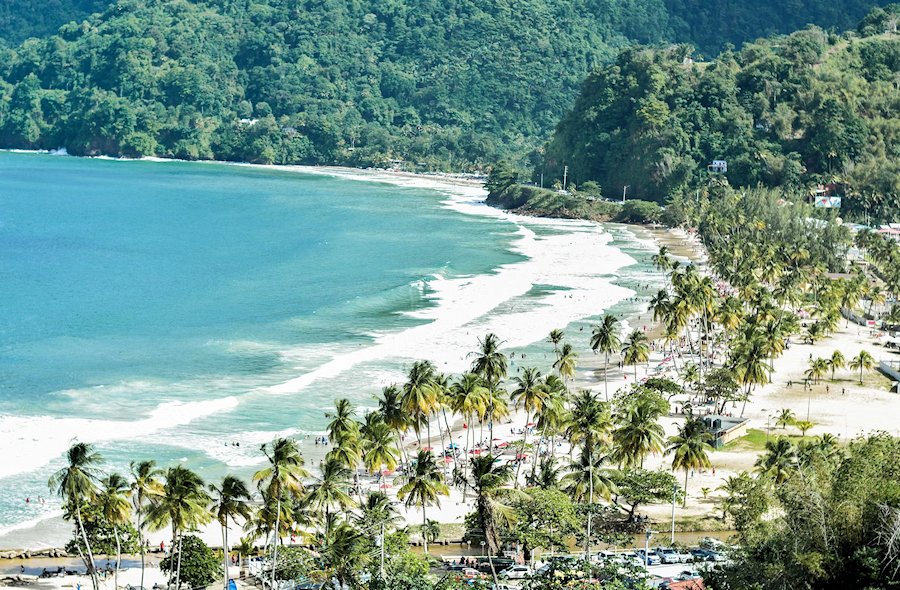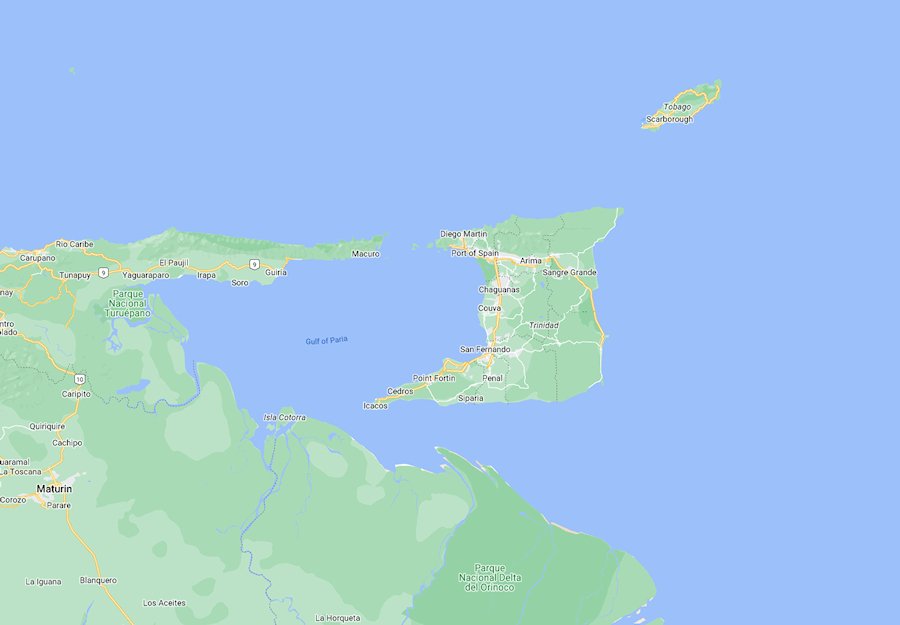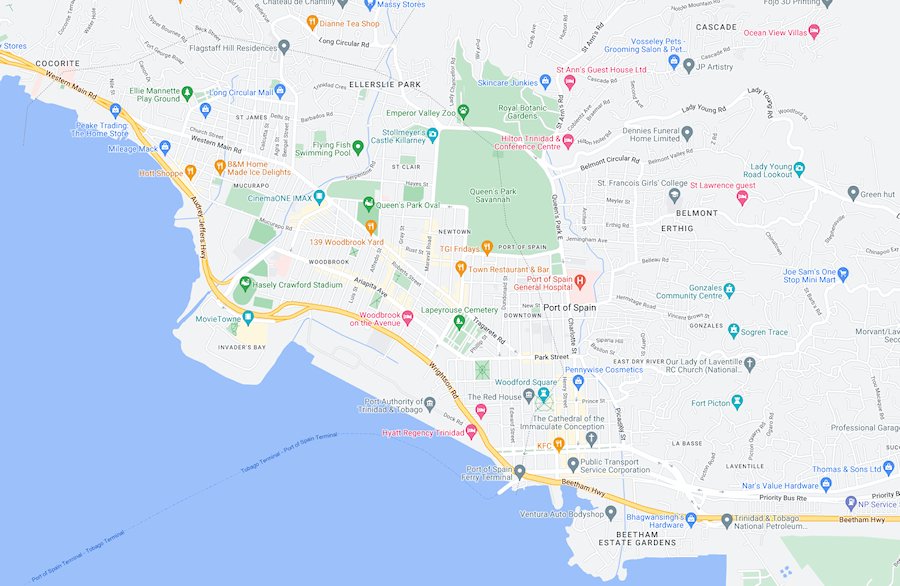Travel Notes: Latin America - Caribbean - Trinidad and Tobago Travel Notes.
Short URL: https://tnot.es/TT
Trinidad and Tobago Travel and Tourism on Travel Notes
Trinidad and Tobago is an island nation in the Caribbean, just off the coast of Venezuela, known for beautiful beaches, diverse culture, and vibrant music.
About Trinidad and Tobago
Trinidad and Tobago is a dynamic and culturally rich country with a diverse population, thriving industries, and stunning natural beauty.
Christopher Columbus landed on Trinidad during his third voyage, on 31st July, 1498.
Today's visitors to Trinidad and Tobago can enjoy a range of activities, from exploring historic landmarks and museums to outdoor adventures like hiking and snorkelling.
 Add a Business - Add a Location -
Add a Lodging - Add Travel Content
- Add URL
- Travel Services.
Add a Business - Add a Location -
Add a Lodging - Add Travel Content
- Add URL
- Travel Services.
Mapping Trinidad and Tobago
Map of Trinidad
Trinidad and Tobago is a twin-island country situated in the southern Caribbean, lying north-east of the South American nation of Venezuela and south of Grenada in the Lesser Antilles.
They are the southernmost of the Caribbean islands.
Trinidad & Tobago Overview
Trinidad is the larger and more populous of the two main islands.
Tobago, the smaller island, covers about 300 square kilometres (116 square miles). The country also includes numerous smaller islands.
Culture
Trinidad and Tobago is known for its vibrant culture; including its annual Carnival celebration, which is one of the largest and most famous in the Caribbean.
The music of Trinidad and Tobago, particularly calypso and soca, has gained international recognition.
The islands also have a rich literary tradition and are home to many talented writers and artists.
Demographics
The population of Trinidad and Tobago is diverse, with a mix of African, Indian, European, and indigenous peoples.
The official language is English, but Trinidadian Creole is widely spoken.
The country has a rich cultural heritage influenced by its diverse population, including music, dance, cuisine, and religious practices.
Economy
Trinidad and Tobago has a mixed economy, with oil and gas being the dominant industries.
The country is one of the leading exporters of liquefied natural gas in the world.
Other important sectors include petrochemicals, manufacturing, tourism, and agriculture.
History
The islands were originally inhabited by various indigenous peoples before being settled by the Spanish in the late 15th century.
Later, Trinidad and Tobago were colonised by the British, who established sugar cane plantations using enslaved Africans.
The country gained independence from Britain in 1962 and became a republic in 1976.
Politics
Trinidad and Tobago is a parliamentary democracy with a president as the head of state and a prime minister as the head of government.
The country has a multi-party political system, with the two main political parties being the People's National Movement (PNM) and the United National Congress (UNC).
Tourism
Tourism is an important industry for Trinidad and Tobago, with visitors attracted to the country's beautiful beaches, diverse wildlife, and rich cultural heritage.
Tobago, in particular, is known for its pristine beaches and coral reefs, making it a popular destination for diving and snorkelling.
Visiting Trinidad & Tobago - Trinidad & Tobago Highlights
Trinidad and Tobago offers a vibrant experience with its rich cultural tapestry, stunning natural landscapes, and warm hospitality.
Remember to respect local customs and traditions, and always be mindful of environmental conservation efforts when exploring Trinidad and Tobago's natural wonders.
Beaches
Tobago is renowned for its beautiful beaches and crystal-clear waters.
Pigeon Point Beach, Store Bay, and Englishman's Bay are just a few of the idyllic spots where you can relax, swim, and enjoy water sports like snorkelling and diving.
Carnival
If your visit coincides with February or early March, experiencing Trinidad and Tobago's Carnival is a must.
This festival is a vibrant celebration of music, dance, and culture, featuring colourful costumes, lively parades, and energetic soca music.
The festivities last for several days and culminate on Carnival Monday and Tuesday, known as 'Mas'.
Historical Sites
Learn about Trinidad and Tobago's rich history by visiting its historical sites and landmarks.
Explore the capital city of Port of Spain, where you can visit the Red House (the seat of parliament), the National Museum and Art Gallery, and the Queen's Park Savannah.
In Tobago, don't miss Fort King George, which offers panoramic views of the coastline and houses a museum detailing the island's colonial history.
Local Cuisine
Sample the delicious flavours of Trinidad and Tobago's cuisine, which reflects the country's multicultural heritage.
Try dishes like doubles (a popular street food made with fried bread and chickpeas), roti (flatbread filled with curried meat or vegetables), and callaloo (a traditional soup or stew made with leafy greens).
Don't forget to indulge in the island's fresh seafood, including shrimp, crab, and fish prepared in various styles.
Local Festivals and Events
Throughout the year, Trinidad and Tobago hosts various festivals and events celebrating its culture, cuisine, and traditions.
These include Divali (the Hindu festival of lights), Hosay (a Shia Muslim observance), and Tobago Heritage Festival; which showcases the island's cultural heritage through music, dance, and storytelling.
Nature Reserves
Explore the diverse ecosystems of Trinidad and Tobago by visiting its numerous nature reserves and national parks.
In Trinidad, don't miss the Asa Wright Nature Centre, home to an array of bird species and lush rainforest.
In Tobago, the Main Ridge Forest Reserve offers hiking trails through dense tropical forest, while the Buccoo Reef Marine Park is perfect for snorkelling and glass-bottom boat tours.
Steelpan and Calypso
Immerse yourself in the vibrant music scene of Trinidad and Tobago, where steelpan and calypso originated.
Visit local venues and festivals to enjoy live performances of these traditional musical styles, which are integral to the country's cultural identity.
Trindad and Tobago Background
The island of the Arawaks and Caribs was colonised by Spain.
The indigenous population soon disappeared, and slaves from Africa were captured to replace them on the plantations.
After successive raids by the Dutch and French, during the 17th century, the island fell to the British in 1797, and was finally ceded to them following the Treaty of Amiens, in 1802.
Tobago was also ceded to Britain at the end of the Napoleonic Wars.
After slavery was abolished in 1833, the British imported more than 150,000 Muslim and Hindu Indian guest-workers, between 1845 and 1917.
Trinidad and Tobago became an independent state in the Commonwealth of Nations on August 31, 1962.
In April 1970 Trinidad suffered serious rioting and a mutiny by part of the army. The state of emergency was finally ended in June 1972.
Trinidad and Tobago Tourism
Visit Trinidad and Tobago
Flights to Trinidad arrive at Piarco International Airport.
Once you land, you're in for a lot of fun.
Liming
Liming is equivalent to hanging out with one person or a group of friends.
Trinidadians are 'limers'; taking their nightlife and entertainment seriously.
Sailing
The island is located outside the hurricane belt, making it a haven for yacht owners throughout the region.
Beaches on Trinidad and Tobago
From hidden gems to local favourites, Trinidad's coastline boasts some pretty unique beaches.
Columbus Bay
Columbus Bay, where Christopher Columbus first made landfall in 1498, is located on Trinidad’s south-western coast.
Maracas Bay
Probably the most popular beach in Trinidad is Maracas Bay on the north coast; a winding 30-minute drive along the mountainside from the capital city, Port-of-Spain.
Tobago Beaches
Tobago is just 20 miles from Trinidad.
Pigeon Point
Pigeon Point has one and a half kilometres of tourist brochure white sand, but you might prefer one of the smaller bays on Tobago.
Turtle Beach
The mile-long sandy beach at Great Courland Bay, on the north-west coast of Tobago, is regularly visited by nesting Leatherback turtles; usually between March and July.
Port of Spain
Map of Port of Spain
The capital is situated on the island of Trinidad.
When the Spanish settled in the area in 1595, they renamed the Native American village of Conquerabia to Puerto de Espana.
Then the British Anglicised it to Port of Spain when they took control of the island in 1797.
Carnival in Trinidad is always a special time, although rooms fill up quickly. Mas and Calypso go together like rum and coconut.
Things to see in Port of Spain
The Royal Botanical Gardens; the National Archives; the National Museum and Art Gallery, an Anglican cathedral (1816-1823); and a Roman Catholic cathedral.
Where to Stay in Trinidad
Trinidad Carnival
Carnival in Trinidad and Tobago is not a parade.
You don’t just stand on the side of the road and watch it go by. You see it, hear it, smell it, taste it, breathe it and live it.
Trinidad & Tobago Travel Guides
Trinidad & Tobago - Trinidad & Tobago Maps.
Weather in the Caribbean:
Local weather forecasts for destinations around the Caribbean region.
More From Travel Notes
Travel Notes Online Guide to Travel
Africa - Asia - Caribbean - Europe - Middle East - North America - Oceania - South America.
The Travel Notes Online Guide to Travel helps visitors plan their trip with country and city travel guides, local tourist information, reviewed web sites, and inspiring travel content.
Travel and Tourism Guides on Travel Notes
If Travel Notes has helped you, please take a moment to like us on Facebook and share with your friends on social media.
Travel Resources
.
Travel & Tourism With Industry Professionals.













